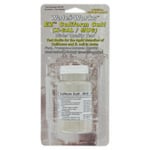We recently received an email from ‘MissThang201’ who said she enjoyed reading many of the entries on our site and then asked…
Everyone in my town has their own well and the other day I heard some neighbors talking about how a new house got built nearby and they can’t get it sold ‘cuz the well keeps having bacteria problems. How does a well get bacteria in it and should we all be worried?
As far as we know, pretty much every state has a law that says a new private well cannot get used until it passes a series of tests for critical drinking water parameters which definitely includes a coliform bacteria test.
Regarding WHY that well keeps failing the bacteria test, any number of things could result in a well repeatedly failing the bacteria test. Below we will list a few of the more common reasons:
Your well may become contaminated with potentially harmful bacteria in one or more of the following ways:
- At the top of the well the cap/cover may have come loose or become cracked/broken allowing debris, insect and possibly even small vermin to get into the well area.
- A (nasty) source of contamination such as a septic system built too close to the well can definitely introduce bacteria as well as nitrates and other unwanted contaminants. Also, a well not having deep enough casing to bypass the area contaminated by nearby septic tanks/fields may also allow bacteria and other things to enter a well and make it unusable.
- Simple problems with sanitation and cleanliness of the tools and other implements used to drill a well may result in a contaminated drill hole.
- Plumbing components such as piping, pumps and/or pressure systems devices may not have received proper disinfection prior to use, assembly and installation.
- ‘Dug’ wells lined with boards, brick, stone and/or tiles may allow unfiltered water and/or what they call near-surface water to seep through and enter the well area — especially if the ground around the well has settled or shifted in any way.
- If the well casing goes into the ground and the ground/rock around the outside of the casing has cracks/crevices near the surface unfiltered and potentially contaminated surface water may work its way down the outside of the casing and eventually find its way down into the aquifer from which the well draws its water.
- In cases where the well casing does not extend far enough above the surface or the base of a hand pump does not have a watertight seal surface water could easily find its way down into the well.
- The head, or top, of the well lies in a depression or area at a lower height than surrounding areas and surface water has the ability to collect/pool around it.
- Older wells may have succumb to nature and developed corrosion spots where surface water could work its way into the well casing.
Like any other part of your house, your well needs periodic maintenance and upkeep. If you do not know what to look for when evaluating a well’s physical well-being, consult with a certified well technician. You can find information that will help you select the right well water specialist for the job on www.WellOwner.org
What if I want to test my own well water every once in a while?
Nothing wrong with that at all! In fact, most well water experts agree that well owners ought to perform periodic testing on their water — just in case. The kits below will test for a number of different critical well water parameters, but always remember that if you have good reason to suspect contamination of your well… you need to seek professional assistance from a certified drinking water testing laboratory.





